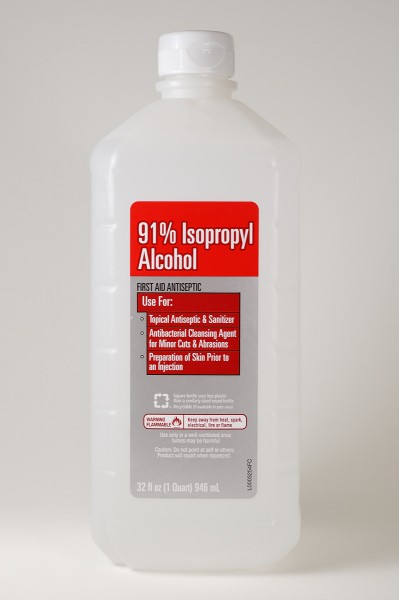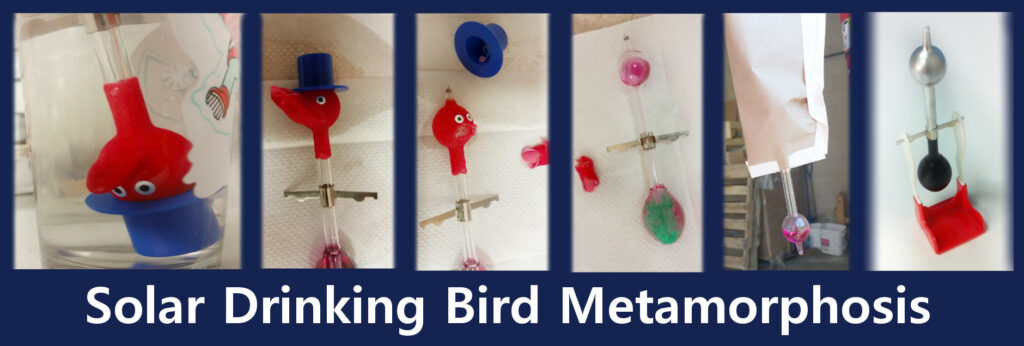 By: Ted Beyer
By: Ted Beyer
Summertime—sun and fun! For most of us (in the northern hemisphere at least) that means hot weather. Heat does interesting things to the world around us, and to us as well. On a hot day you tend to perspire. Your body does this for a good reason: as the moisture evaporates, it cools your skin, and thus helps to regulate your body temperature.
In contrast, dogs don’t perspire—they don’t have sweat glands! So on a hot day you will see dogs panting—lots of rapid, shallow breaths with their tongues looking bigger than usual hanging out of their mouths. That’s the doggie way of cooling off. They are moving air over a wet surface—again using evaporation to lower their body temperature.
 Our Drinking Bird (DB-100) is also lacking in sweat glands… but it DOES have a red, slightly fuzzy, head. Get that fuzzy stuff wet, and the water will immediately start to evaporate—causing the air in his head to cool which, in turn, makes that air contract and lower the pressure. When that happens, the pressure in his lower chamber is slightly higher than in the upper chamber (his head). As a result, the fluid travels up the connecting tube and eventually changes the center of gravity sufficiently to make him “drink.”
Our Drinking Bird (DB-100) is also lacking in sweat glands… but it DOES have a red, slightly fuzzy, head. Get that fuzzy stuff wet, and the water will immediately start to evaporate—causing the air in his head to cool which, in turn, makes that air contract and lower the pressure. When that happens, the pressure in his lower chamber is slightly higher than in the upper chamber (his head). As a result, the fluid travels up the connecting tube and eventually changes the center of gravity sufficiently to make him “drink.”
So far, so good. But since it’s summertime, perhaps our friendly Drinking Bird has some party animal in him—why not persuade him to drink alcohol? (This works nicely with rubbing alcohol, but you can get fancy and use acetone or any number of other things if you like.) Since water is made up of molecules that have comparatively strong bonds, it evaporates more slowly than the party boy carbon atoms in the alcohol, whose bonds are far weaker.
Need proof? If you dip your finger into water at room temperature, it feels a little chilly until it dries completely. But if you dip your finger into room temperature rubbing alcohol, your finger will feel far colder—and be completely dry far more quickly—than with the water.
 What happens if we have our Drinking Bird party hearty with some rubbing alcohol? (Note: be sure to be very careful if you try this. Alcohol is, of course, flammable, so keep flames and sparks away from your experiment area.) What if we give him a designated driver who is drinking nothing but water? Our party bird will drink much more quickly than his tea-totaling friend. The faster rate of evaporation of the alcohol will cool his head more rapidly, causing the exact same process to occur much more quickly in the alcohol chugging Drinking Bird.
What happens if we have our Drinking Bird party hearty with some rubbing alcohol? (Note: be sure to be very careful if you try this. Alcohol is, of course, flammable, so keep flames and sparks away from your experiment area.) What if we give him a designated driver who is drinking nothing but water? Our party bird will drink much more quickly than his tea-totaling friend. The faster rate of evaporation of the alcohol will cool his head more rapidly, causing the exact same process to occur much more quickly in the alcohol chugging Drinking Bird.
Of course, drinking too much has consequences… and some of them can be quite serious. In this case, it turns out that alcohol (and acetone, etc.) doesn’t just evaporate on the Drinking Bird’s fuzzy head—it also dissolves the glue that holds our friend together! Slowly but surely his face will melt off, his hat will detach from his head, and even his beak will fall victim to his reckless lifestyle. I know, I know—you are thinking that I am trying to get you to buy a fleet of Drinking Birds since this experiment will ultimately destroy them.
Would I do that to you? Not to worry – I have a plan!
Here’s the plan…
We are going to need to clean off our bird entirely—the hat, the beak, his eyes, all the red stuff on his face, and his feather as well. This might take some extra solvent and a little elbow grease. Be careful! He is, after all, made of glass, so take care not to break him. A nice soak will take care of most of it.
Well now this is a problem. We have a totally naked bird; poor guy must be incredibly embarrassed. Let’s see if we can’t help him out. We’ll need two cans of spray paint: one can of flat black, and one of metallic silver. (Check to make sure it will adhere to glass.) Mask off half the bird, from the metal crossbar down. Then paint both sides of the top half with the silver paint. Wait for it to dry completely. Now mask off the newly-painted area and proceed to paint the other half of the bird with the flat black paint.

Okay. So we have a somewhat odd looking, but actually rather stylish two-tone Drinking Bird. Now what?
Well, it’s summer—time to get some time out in the sun. No sunscreen needed for this bird! Place the bird out in the sun, and very slowly, but surely, he will start to bow—we really can’t call it drinking anymore, can we?
Configured like this, we have inverted the way he works—the black paint on his lower half will absorb more of the heat from the sun than his upper half with its reflective coat of silver paint. That heat in his lower chamber will cause that air to expand, thus pushing the liquid up. Of course his days as a hard drinking bird are no more—partly because he no longer needs to drink at all, but also since the temperature differential between his top and bottom half will be far smaller than it was when drinking water—never mind the alcohol.
I have come to call this bird a “Solar Drinking Bird.” When it’s really hot out, it can take him quite a while to start drinking (as much as 20 – 30 minutes if he was in air conditioning before you took him outside). He will work at nearly any temperature just as long as he is in direct sunlight. In fact, he will work better in cooler temperatures than in the heat of the summer.
Presenting… our newest Drinking Bird!
No interest in making a Solar Drinking bird, but still interested in what happens with different cocktails for our drinking buddies? Educational Innovations now offers the Giant Drinking Bird (DB-125). He is not only vastly larger, but has another feature that works to our advantage in this case: he is all glass, so there’s no fuzzy stuff to melt off. That means that we have no face melting consequences to his drinking habits. His beak is covered in tiny, blunt glass chips that use surface tension to hold the liquid.
When we got him, I just had to try the experiment out, so I timed his drinking frequency with water. In the conditions we had in our break room at that time, he was drinking at an average rate of once every minute and 44 seconds. I replaced his water with acetone. Not always a nice thing to do to a poor guy with no warning at all. Still, as expected, he REALLY got into it. We were all stunned to discover that his drinking frequency, under identical conditions, rocketed to a nearly unbelievable 7.3 seconds on average. Now THAT’S what I call a party animal.
There are many other items that Educational Innovations sells that put me in mind of summer—I’ll see what I can do about another tour sometime soon. In the meantime, here is a tip to help you keep cool: use a spray mist of water to cool the air around you (those of you who live is desert climates already know what I am talking about). Don’t forget the sunscreen, and have fun!
Great! My 1st graders love the drinking birds. We explain it as best we can (evaporation is key, and they do understand that much.) Then we get them (the birds) drinking, & use timers to count the drinking frequencies in 3 minutes. During the next round, we give each kiddo a notecard with instructions to fan the little critters. We always get a significant frequency increase with the fanning. You could do it with middle or high schoolers & get some serious statistics out of it. You’ve just about talked me into trying a glass model!